Cala d'Or
Cala d'Or is a village on the east coast of the island of Majorca, in the municipality of Santanyí, Balearic Islands, Spain.
Cala d'Or | |
|---|---|
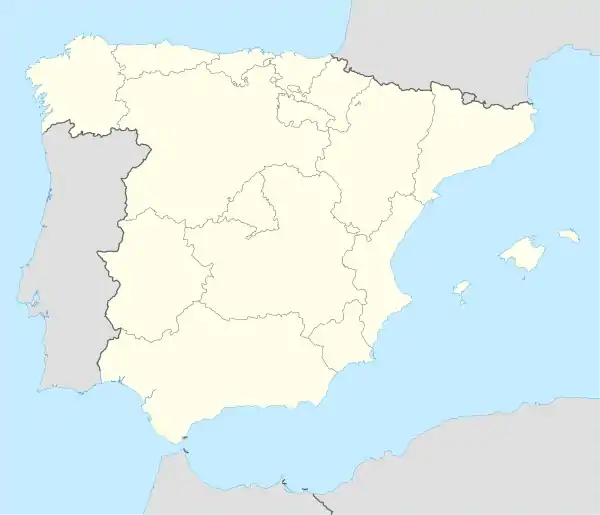 Cala d'Or Location in Spain | |
| Coordinates: 39°22′27″N 3°13′52″E | |
| Country | Spain |
| Autonomous community | Balearic Islands |
| Province | Balearic Islands |
| Comarca | Migjorn |
| Judicial district | Manacor |
| Municipality | Santanyí |
| Elevation | 62 m (203 ft) |
| Population (2013) | |
| • Total | 3,823 |
| Demonym(s) | Caladoreño |
| Website | Official website |
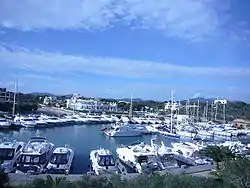

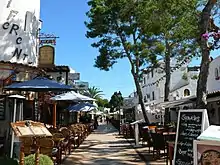


Geography
Cala d’Or area belongs to the municipality of Santanyí, which lies further inland. The capital town Palma and Palma airport is approximately 60 Kilometers away.
The Village of Cala d’Or unfolds itself on three promontory along the southeastern coastline. It is consisting of three principal areas: Cala d'Or (centre), Cala Egos (westside) and Cala Ferrera (eastside). A part east from Avenida Felanitx already belongs to the municipality of Felanitx.
The rough coastline is cut by several bays and sandy beaches. From East to West these are: Cala Esmeralda ("emerald green"), Cala Gran ("big"), namegiving Cala d’Or (bay and beach), ("golden", also called Caló de ses Dones) and Cala Llonga ("long", also called Cala d’es Forti) with its small Caló d’es Pou. In western part of Cala Egos these are: Cala Egos (bay and beach), Cala Galera und Caló des Llamp. In western part of Cala Ferrera (already belonging to Felanitx) these are: Cala Ferrera (bay and beach) and Cala Serena ("serenity").
The nearby village of Portopetro can be reached by bus or car within five to ten minutes.
History
Fort Es Forti was erected in 1740 and destroyed by an earthquake in 1793, but re-erected. It protected the coastline against pirates. Today it is one of view historic sites in Cala d'Or and Santanyí.
Its four sides are 26 meters each. At seaside there are hatches for cannons to fight oncoming ships. At landside there are slits to shoot out and fight against oncoming troopers.[1] The Fort has four cannons and 19 soldiers.[2]
1932 Josep Costa Ferrer (1876 bis 1971), an artist, illustrator and architect from Ibiza, later called Don Pep Costa, planned a modern urbanization for tourism and vacations. He called the new village first after Cala d'Hort on island of Ibiza, but mallorquean settlers changed it to Cala d’Or („Golden Bay“).
Village and Harbour
The centre of Cala d'Or is situated along both sides of Avenida Boulevard d' Or between of Complejo de Font Major (building) and Plaza de Ibiza (las Columnas) north of Cala d’Or-Bay and Cala Gran-Bay. Also shops, restaurants and bars can be found on the eastside in Cala Ferrera along road S'Espalmador near to Cala Ferrera-Bay and Cala Esmeralda-Bay, on the eastside in Cala Egos along road Avenida de Marina near to Cala Egos-Bay and along road Avenida de Cala Llonga in the marina and along road Avenida de Baixada in the port.
The majority of buildings in Cala d'Or are painted white in a Mediterranean tradition. The outskirts of the settlement are home to holiday villas whereas nearer to the coast it is dotted with several hotels and apartments. In general buildings are small and cubic, the design therefore called Ibiza-style. This is no coincidence, because the ibicean architect Josep Costa Ferrer was inspired by his patrimony when he was planning Cala d'Or.
The Church Santa María del Mar was erected in 1956.
The town centre is very lively in the summer months but much more low key than the larger and more populated resorts in Majorca. The pedestrianised area offers a variety of shops, bars, and restaurants with local and international cuisine.
The marina is situated in Cala Llonga, a large and longstreched bay. The marina offers 563 boatplaces within a 30.000 m² area.[3] Also popular is the marina area which welcomes yachts and chartered boats throughout the year, offering some of the best protection from storms in the whole of Majorca, although the entrance can be very tight for turning. The marina offers some exclusive restaurants and bars.
The resorts of Cala d'Or are very popular with families or couples from all over Europe.
Cala d'Or was one of the first major tourist resorts in Mallorca. The buildings were themed on Ibiza, small pretty white-washed villas, apartments and houses and even the hotels had to stick rigidly with this theme.
Over the years this area has grown in size and more and more tourists come to explore fine dining and enjoy the quiet areas near the natural park of Mondrago. Many of the hotels in Cala d'Or & Cala Egos offer all-inclusive holidays, but there are also luxurious villas and apartment for rent.
Cala d'Or attracts mostly western European tourists such as Germans, British and French.
Traffic
Roadtraffic in Cala d'Or is guided by traffic circles (1–19), which are decorated by sculptures or plants. Coming from Calonge and a northern direction you approach traffic circle 1 at the northside of the village. Coming from Portopetro and a western direction you approach traffic circle 11 at the westside of the village. Coming from S'Horta and a northeastern direction you approach traffic circle 6 at the eastside of the village.
A Minitrain runs for holidaymakers and is connecting all parts, bays and beaches in Cala d’Or.
With Red Bus by TIB, operated by a private transportation provider, Cala d’Or is connected to other villages and towns.
Gallery
_05.jpg.webp) traffic circle 1, northern entrance to Cala d’Or
traffic circle 1, northern entrance to Cala d’Or_02.jpg.webp) traffic circle 2, sculpture, Kiss, hommage to Constantin Brâncuși
traffic circle 2, sculpture, Kiss, hommage to Constantin Brâncuși_02.jpg.webp) traffic circle 11, western entrance to Cala d’Or
traffic circle 11, western entrance to Cala d’Or Cala Llonga and
Cala Llonga and
Marina of Cala d'Or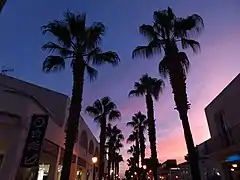 Cala d'Or by night
Cala d'Or by night
Bays and Beaches in village
.jpg.webp) Cala d’Or (Bay)
Cala d’Or (Bay)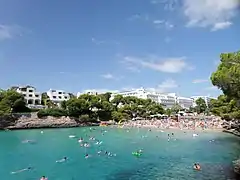 Cala Gran
Cala Gran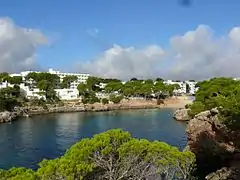 Cala Esmeralda
Cala Esmeralda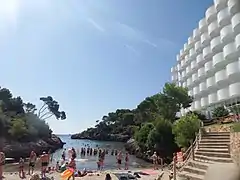 Cala Egos
Cala Egos
- Cala d’Or
- Cala Gran
- Cala Esmeralda
- Caló d’es Pou
- Cala Egos
- enclosed
- Cala Ferrera (Felanitx)
- Cala Serena (Felanitx)
Nearby locales
- Cala sa Nau, northeast from Cala d’Or, approx. 4 km away.
Parc natural de Mondragó
- S’Amarador and Ses Fonts de n’Alís, southwest from Cala d’Or and Portopetro, approx. 5 km away.
Both beaches are situated in Cala Mondragó in the nature protection area Parc natural de Mondragó.
The Parc with free entrance is recommended for hiking or sunbathing or swimming.
References
- www.ajsantanyi.net/de/Es Forti
- www.mallorcamagazin.com/Es Forti reopend (08.04.2019)
- Der Hafen, marinacalador.es, download at 10. October 2019
| Wikimedia Commons has media related to Cala d'Or. |
